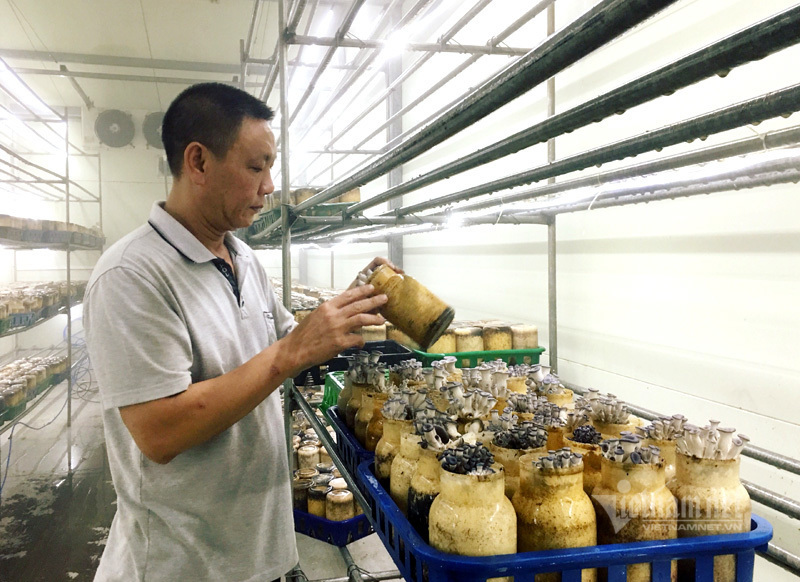Matsutake mushroom
 |
|
|
In recent years, during the vegetarian season (lunar July), wealthy Vietnamese people look for matsutake mushrooms. The price for a kilogram of fresh matsutake is VND18-20 million and VND30 million for a kilo of dried mushroom.
Matsutake mushroom is commonly found in conifer forests of 2,500 meters from sea level that are covered with fog, snow, and high humidity all the year round in countries like Japan, South Korea, China, Bhutan ... In these countries, this kind of mushroom is often considered a rare and valuable gift.
Explaining the expensive price of this mushroom in Vietnam, some sellers said that this is a natural mushroom that cannot be grown. In the current COVID-19 pandemic, the transport of mushrooms to Vietnam is complicated, so the price increase is inevitable.
This kind of mushroom has a unique taste and aroma, with thick, crispy and sweet meat.
Green Ironwood mushroom (Ganoderma lucidum)
 |
This kind of mushroom is also one of the most expensive mushrooms hunted by rich Vietnamese. This is a mushroom found extensively in primeval forests.
The mushroom grows only on dead rotten limestone trees. From May to mid-August is the time when people in many mountainous provinces go hunting for green Ironwood mushroom. To find the green Ironwood mushroom, they have to go deep in the forest.
Due to the limited quantity, the price of fresh green Ironwood mushrooms ranges from VND1-2 million per kilo, depending on the type. Dried mushrooms can cost up to VND3.5 million per kilo.
Poria cocos wolf mushroom
 |
Poria cocos wolf mushroom can usually be found growing in mountainous northern provinces such as Lao Cai and Yen Bai.
This type of mushroom weighs between 500 grams and 2 kilos, while the giant version of the mushroom can weigh around 10 to 15 kilos. Usually its price hovers from several of hundreds to over VND1 million per kilo.
The price of the mushroom is approximately VND1 million per kilo. Buyers normally have to order several days in advance to ensure their purchase.
This kind of mushroom is called "Vietnamese ginseng" because of its medicinal value. The mushroom grows only on the top of Abies delavayi (pine species) and is abundant in Hoang Lien Son mountains in the northern mountainous provinces of Lao Cai and Yen Bai.
In ancient Chinese books, it is said to be more effective than Korean ginseng in nourishing and balancing the body, restoring health, actibg as a diuretic, detoxifying, treating edema, treating melasma, freckles ...
Macrolepiota albuminosa mushrooms
 |
Macrolepiota albuminosa, or termite mushroom, is a species of agaric fungus in the family Agaricaceae that is an obligate symbiont of termites. First described scientifically as Agaricus albuminosus by Miles Joseph Berkeley in 1847, it was transferred to the genus Macrolepiota by David Pegler in 1972. The fruit bodies (mushrooms) of the fungus are edible. It is found growing from termitaria in grassy fields, hills, and or forest borders in China and Vietnam. It only grows in wild nature and people cannot grow it in gardens.
The mushroom is about 4-6cm tall, the trunk is round, the mushroom ears are cone-shaped or a round beret. The color of the mushroom is light gray or white gray when it is young and it turns ivory-white with time.
Termite mushrooms usually bloom in about 2-3 months a year, at the beginning of the rainy season, from May to August of lunar calendar in the Southeastern provinces such as Binh Duong, Binh Phuoc, Vung Tau and Ben Tre.
Because it grows naturally and only appears for a short time, termite mushrooms are also expensive, priced nearly VND1 million per kilo.
Hanh Nguyen

Leaving university, he now earns VND30bil/year from growing mushrooms
Trieu Quang Trung decided to leave university to pursue his passion – growing mushrooms. He now owns a mushrooming growing facility which brings turnover of VND30-36 billion a year.